Roll 5: Tri X @400asa
 Wednesday, July 20, 2011 at 3:53AM
Wednesday, July 20, 2011 at 3:53AM 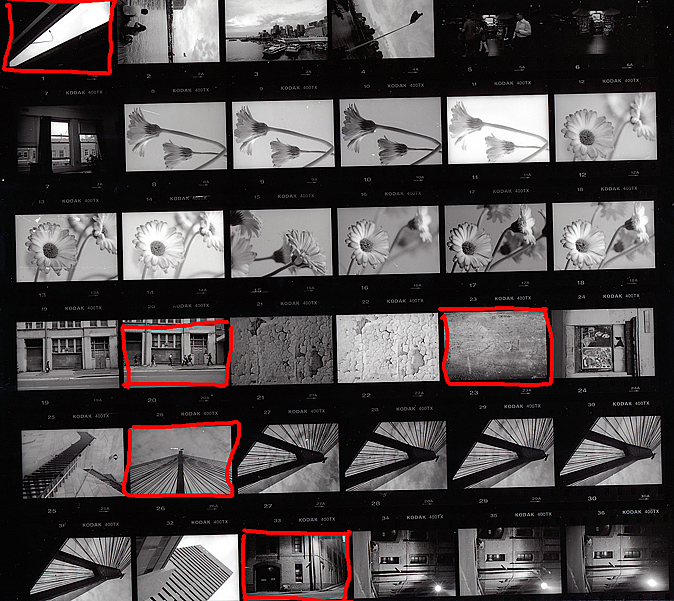
Proof Sheet #5
Here I was shooting Kodak Tri-X with EI400 developed in Rodinal 1:50 for 12:30sec at 21C with agitation for the first minute and then for 10 seconds every minute afterwards. I used water as a stop bath, Kodak Rapid fixer for 5 minutes and finally Hypo Clear for 2 minutes before the final water wash. This was developed in the same tank as roll 4.
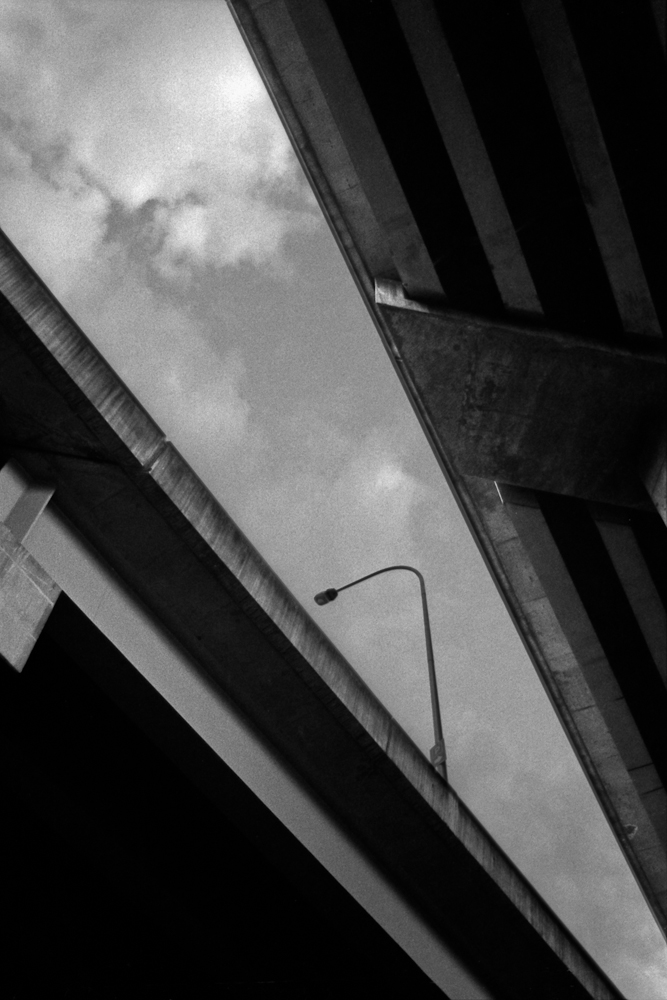
Over Pass
I love getting underneath these road bridges and taking shots looking up, there is just something to be said for the gentle curves. This is the type of composition that I am drawn to once again for the overall simple geometric shapes of the three triangles. Okay so one is more a rhombus but you know what I mean.
I have done some digital post production here. I pulled back some of the cloud detail with the recovery slider and dodged under the brides to get some shadow detail.
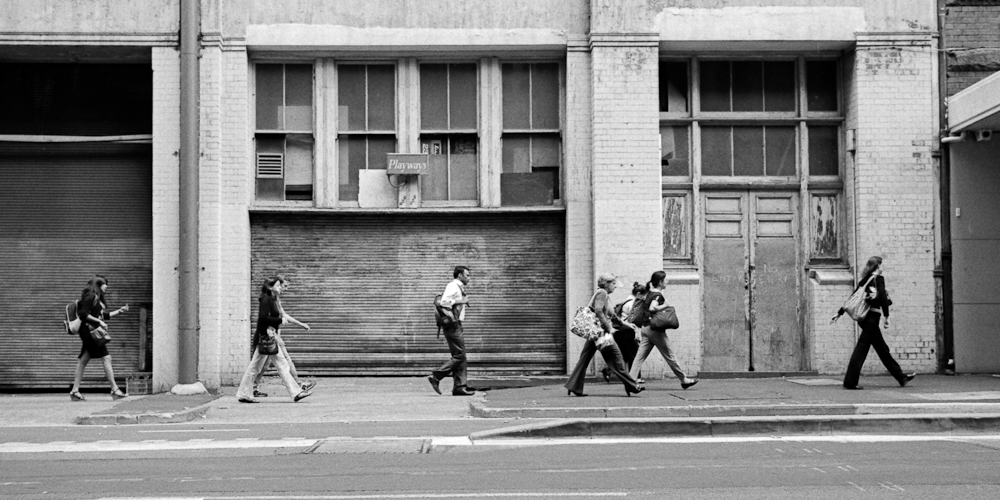
Walking
If you spend enough time in the city just watching people you will see that there is a natural rhythm just like you heart has a beat. In the city this is caused by most people following social conventions to wait and traffic lights or a bus just arriving and dropping off its passengers. So as I was waiting for someone to walk past this back drop I either had no one or a bunch of people.
I have cropped this down to give it a more panoramic fell and to exaggerate the left and right hand space.
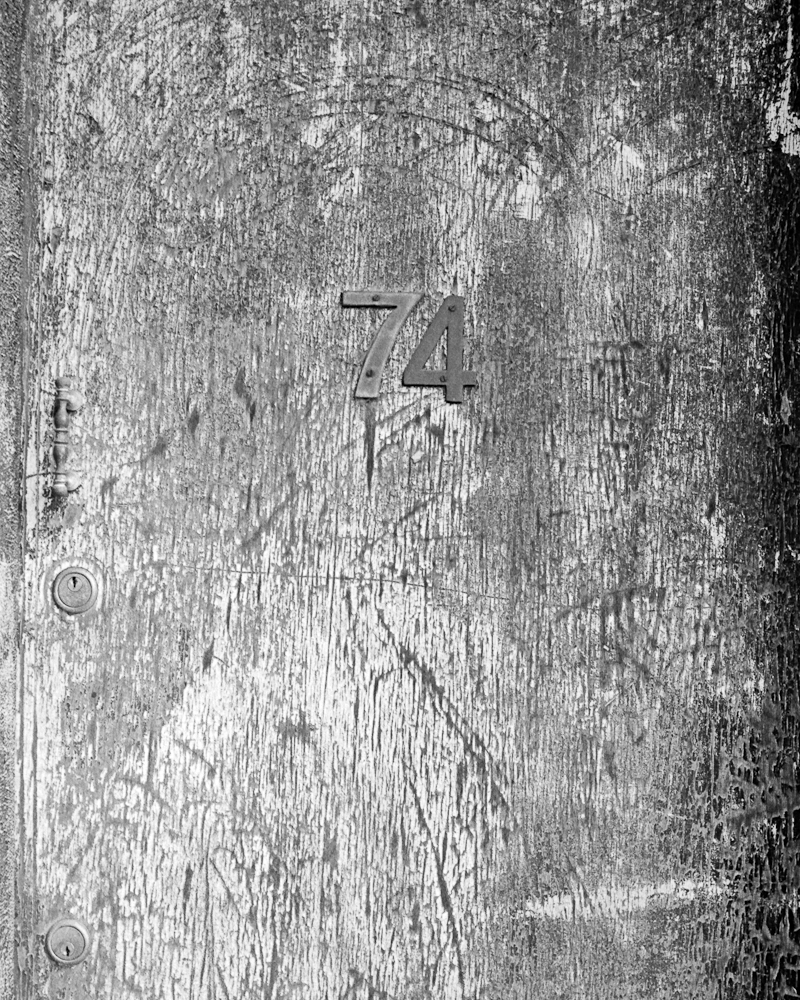
Number 74
This is a lovely old door hidden in a side street down in Pyrmont, isn't all the texture just great. Generally side lighting is the best to bring out this texture however here the right hand side ended up in the shadows which I don't partially like.

Triangular Anzac Bridge
Once again some simple geometrically patterns have caught my eye. I spent some time trying to get a symmetrical shot but the wires that are used to support the bridge did not want to corporate with me, maybe I should have tried standing in the middle of the road.
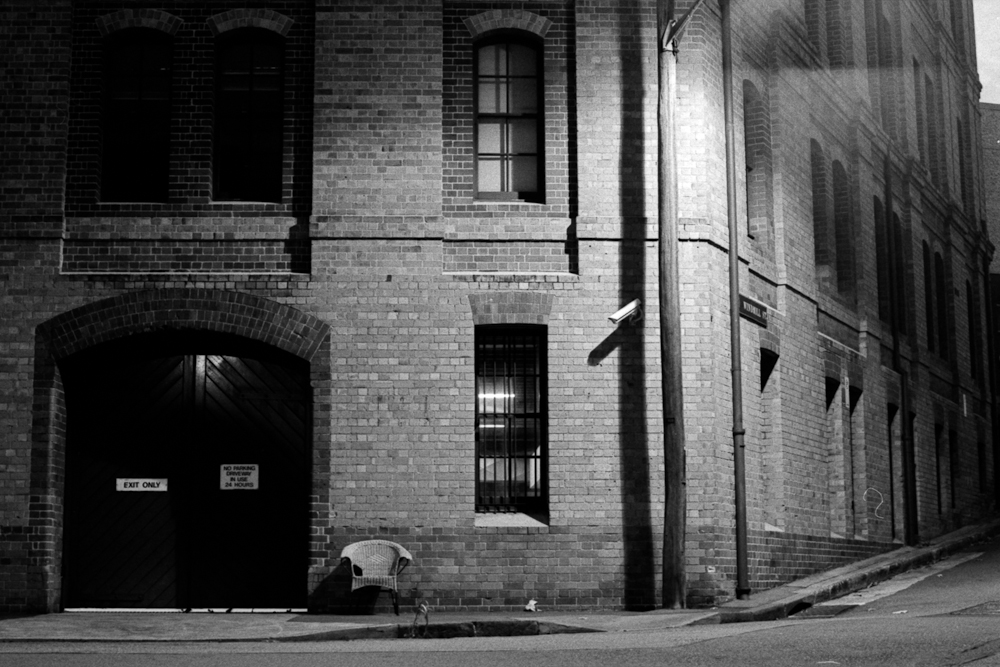
Surveillance on Nobody
This shot was taken just around the corner from where I took the shots of the Palisade in the previous roll. What drew me to this location was the security camera and its shadow on the brick wall with the cool street lighting, but I had just heard about a photo exhibition in england that was photographs of surveillance devices.
So with that in mind I decided to stop and take a shot, but to make it a little different I placed this chair directly where the security camera was pointing. No I don't carry around prop chairs, this one was conveniently placed about 5 meters from where I took this shot.
Roll 4: A Lack of Red Filtration
 Tuesday, July 12, 2011 at 11:18AM
Tuesday, July 12, 2011 at 11:18AM 
Contact Sheet 4
Here I was shooting Kodak Tri-X with EI400 developed in Rodinal 1:50 for 12:30sec at 21C with agitation for the first minute and then for 10 seconds every minute afterwards. I used water as a stop bath, Kodak Rapid fixer for 5 minutes and finally Hypo Clear for 2 minutes before the final water wash.
The reasons that I gave this post a sub heading of A lack of red filtration is if you look at the second half of the roll I was shooting out doors and blowing almost all the detail in the sky. If I had been smart and added a orange or red filer I would have held a little bit more detail, even if the sky was over cast. This is something I will dedicate a post too, but for now check out the following web page on using coloured filters with black & white film.
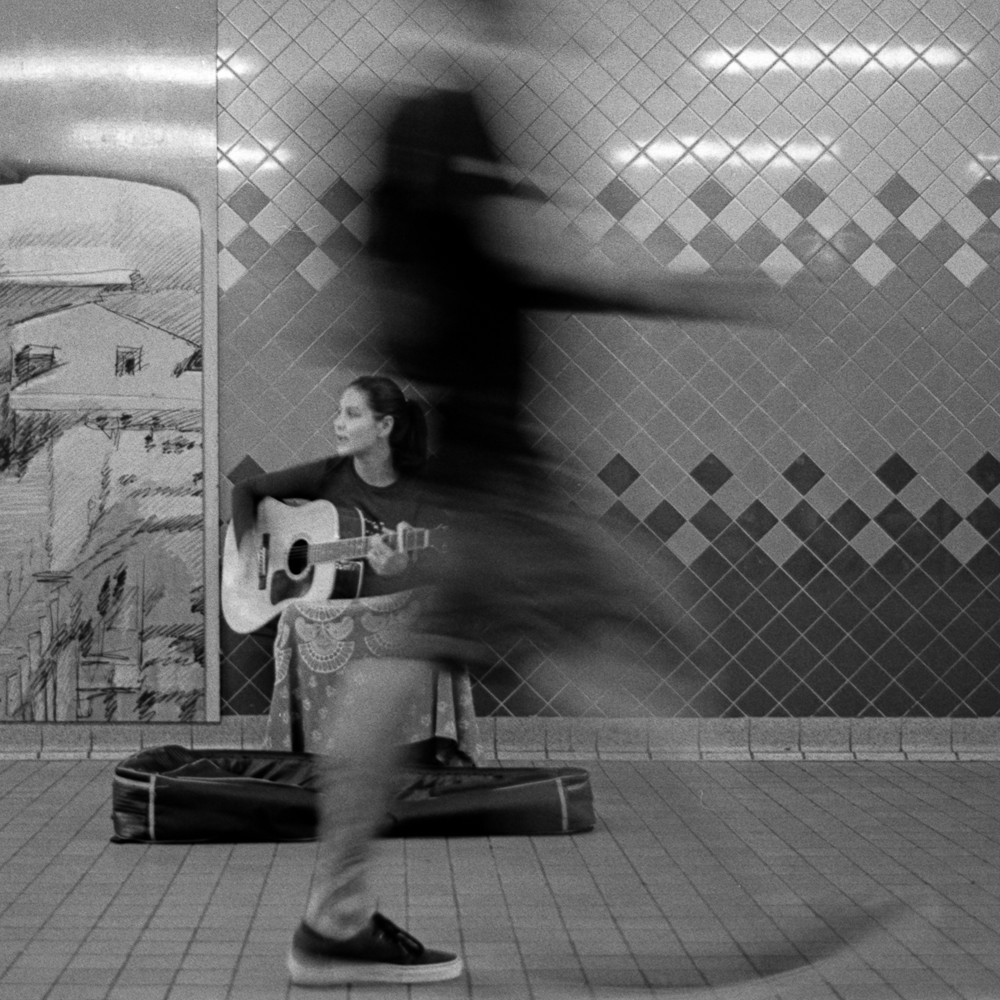
'Hippy Tunnel' Music
Before taking this shot I had seen her a couple of times as I was making my way to Central station late in the evening, she has quite a voice that fills the tunnel.
Here I was trying to capture someone just passing her by, like most of do with these street performers. Getting the timing for this was quite hard as I wanted the blurred subject to be reasonably close to her but still in frame (not as close as I managed to get). Unfortunately as I was hand holding with such a long shutter speed she became blurred as well, next time I will have to use a tripod or some other type of support.

Flower Light Shade
These are the same flowers as you have seen in the earlier proof sheets, however by now they were really starting to droop. Here I am using an extension tube and a Nikkor 135 f3.5 lens to get in nice and close. I am using natural diffused sun light from the glass door of my dining room.
At the time of taking the shot I was not thinking about cropping and rotating the image like I ended up doing.

Designer Layout
I love walking to photo locations as you never know what you might find on your way that will make a good photograph. Here I was heading down the the Rocks in Sydney instead of walking down George street, (which is what I normally do) this evening I decided to walk down on of the parallel streets instead for a fresh look.
As I was keeping an eye out for chances to make photographs I notice this lovely room lucky for me I could take this shot though a glass window while standing on the sidewalk.
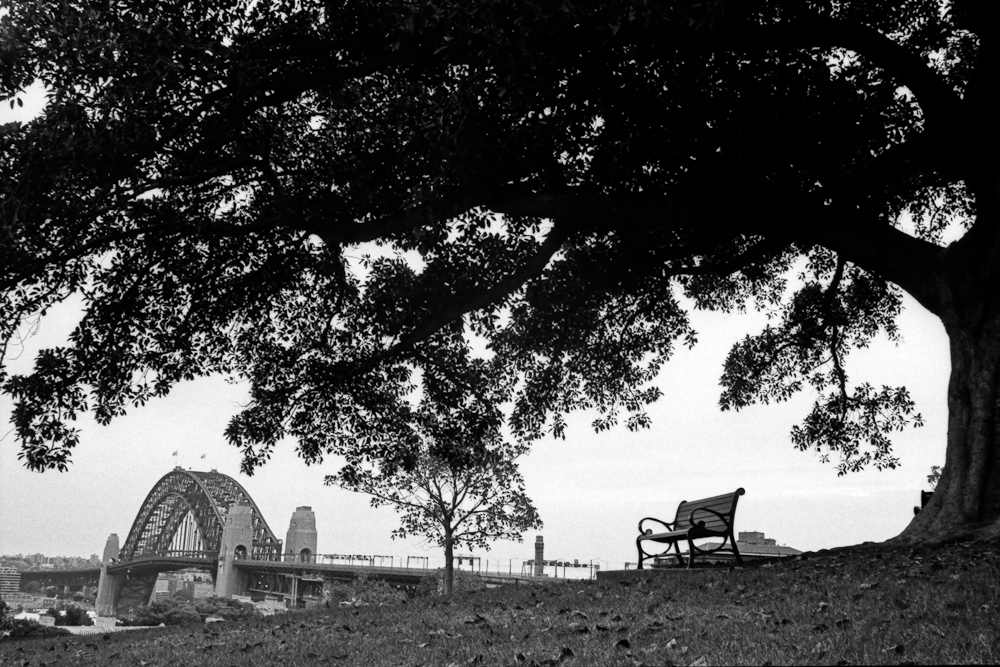
Harbour Bridge and Fig Tree
This is rather popular place for wedding photographers on the weekends. I happened to be there for the sunset on a weekday and had the park all to my photographic self, there were still couple on benches and women walking their dogs but I was the only one with a tripod.
This is the classic shot of the harbour bridge from this location where you would use the fig tress to frame your subject, here I included the bench as well but I did not do a good job of separating it from that ugly building (and the one poking out of the trunk) in the background.
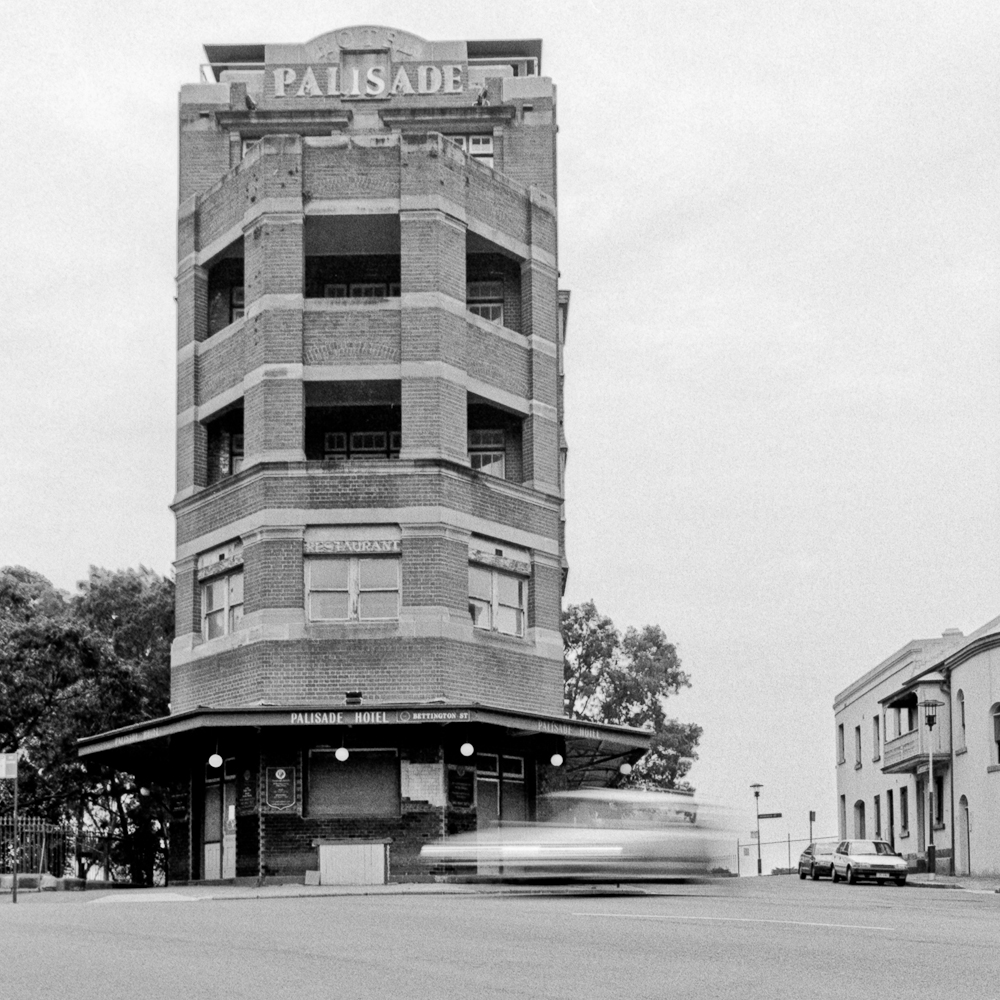
Abondend Palisade
For every one who lives in a city there are still many new places to explore and this is one such place for me. This is the start of a little pocket of Milsons Point that is tucked away from the rest of the city though this will probably change after the redevelopment is put in. There is something that draws me to this location, it is this lonely old style of pub that sits lifeless or something else? If you look around sydney you will find that there are many other such pubs sitting there lifeless. (link to article)
This was quite a difficult shot and I still don't think that I got it right. I was using a PC lens to try and keep the verticals straight which I almost got right there is still some distortion. The sky has lost detail for two reasons the sun was in front of me (but not directly in frame) and secondly it was a rather gloomy day. I have since learnt that if I had used a red filter I might have been able to get a bit more cloud detail. (A topic for a future post)
Photographic Heros: Alfred Stieglitz
 Sunday, June 12, 2011 at 1:24AM
Sunday, June 12, 2011 at 1:24AM This is the first in a series called Photographic Heros. To me a photographic hero is anyone that has left their make in the history of photography, oh and they have to have passed away. While hero generally indicates that the person is male, I will however be including both genders under this banner. I will do also do a separate series on photographers (who are alive today) that inspire me.
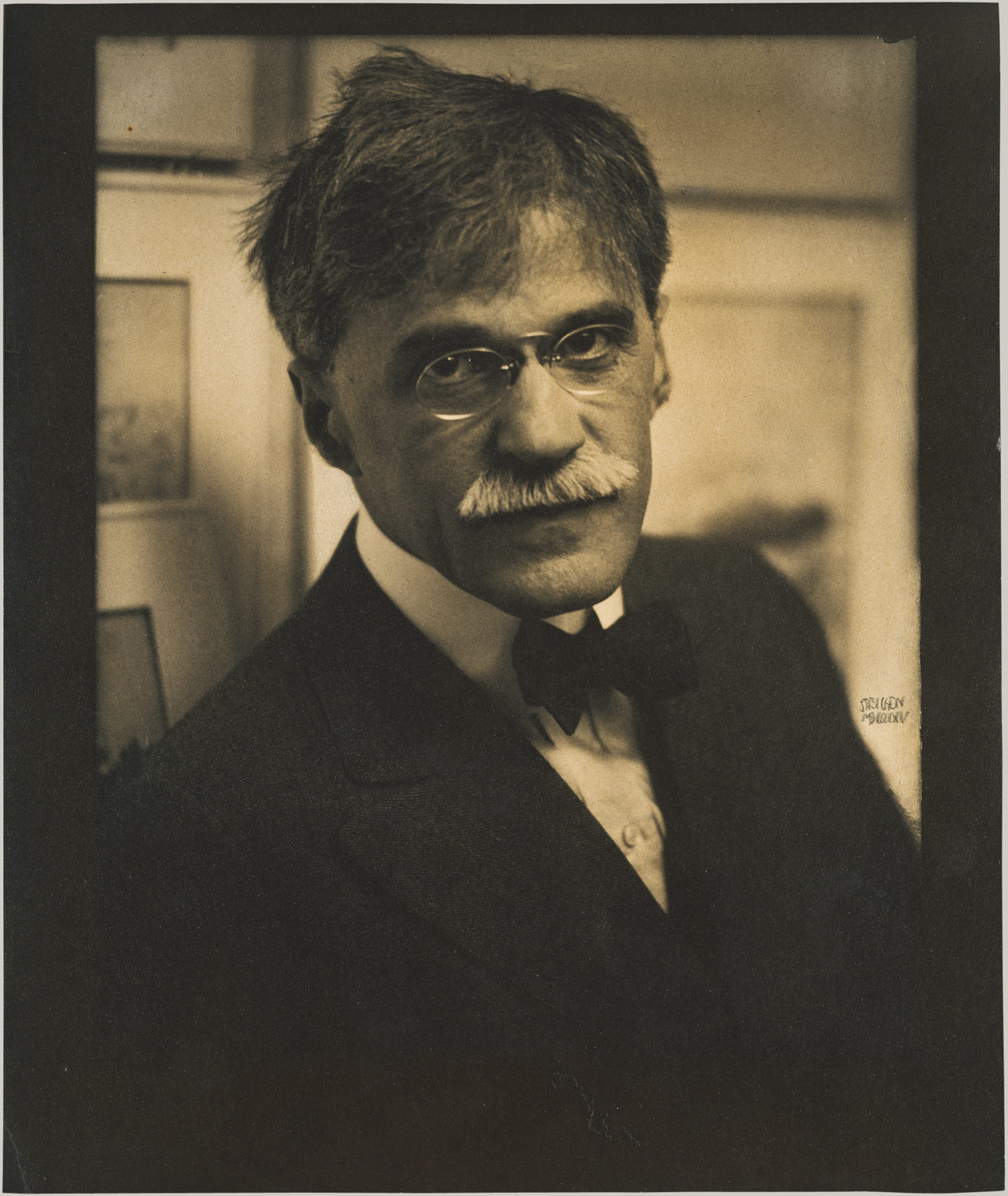
Alfred Stieglitz (January 1, 1864 – July 13, 1946)
Stieglitz was one of the major American photographers at the start of the 20th century. However, to me at least, he deserves his place in history for being a promoter of modern art and being instrumental in making photography an accepted art form.
There is already a so must on the internet about Stieglitz that I shall not add to but but direct you to some of the more worthwhile pieces. The video below is quite a good over view of his life.
[youtube=http://www.youtube.com/watch?v=8YhwYgdtphE]
If you are looking for a more historical view of his photographical work then Jeff Curto a Professor of Photography at DuPage has an interesting lecture on Stieglitz The link for that lecture is here.
If you look at Stieglitz's photographic work there are three major bodies of work that appear to my mind. Portraits of his liver and later wife Georgia O'Keeffe, urban shots of New York city often taken from his art galleries windows and his abstract series photographs called Equivalents. Lets have a look at an example of each.
Georgia O'Keeffe, 1921
This is one of the many (over 300) photographs that Stiglitz made of Georgia O'Keeffe. One key thing to note here is the use of the hands, which appear in almost every portrait that he took of her, there is something sensual about them. What I like about this photograph is the lines of her neck and the unusual crop that he used for this photograph and the beautiful sepia tones.
Lisa Kurzner is an art historian who has looked at the development of the ideas of photographers in the early 20th centry though his portraits of his wife . You can find the lecture here.
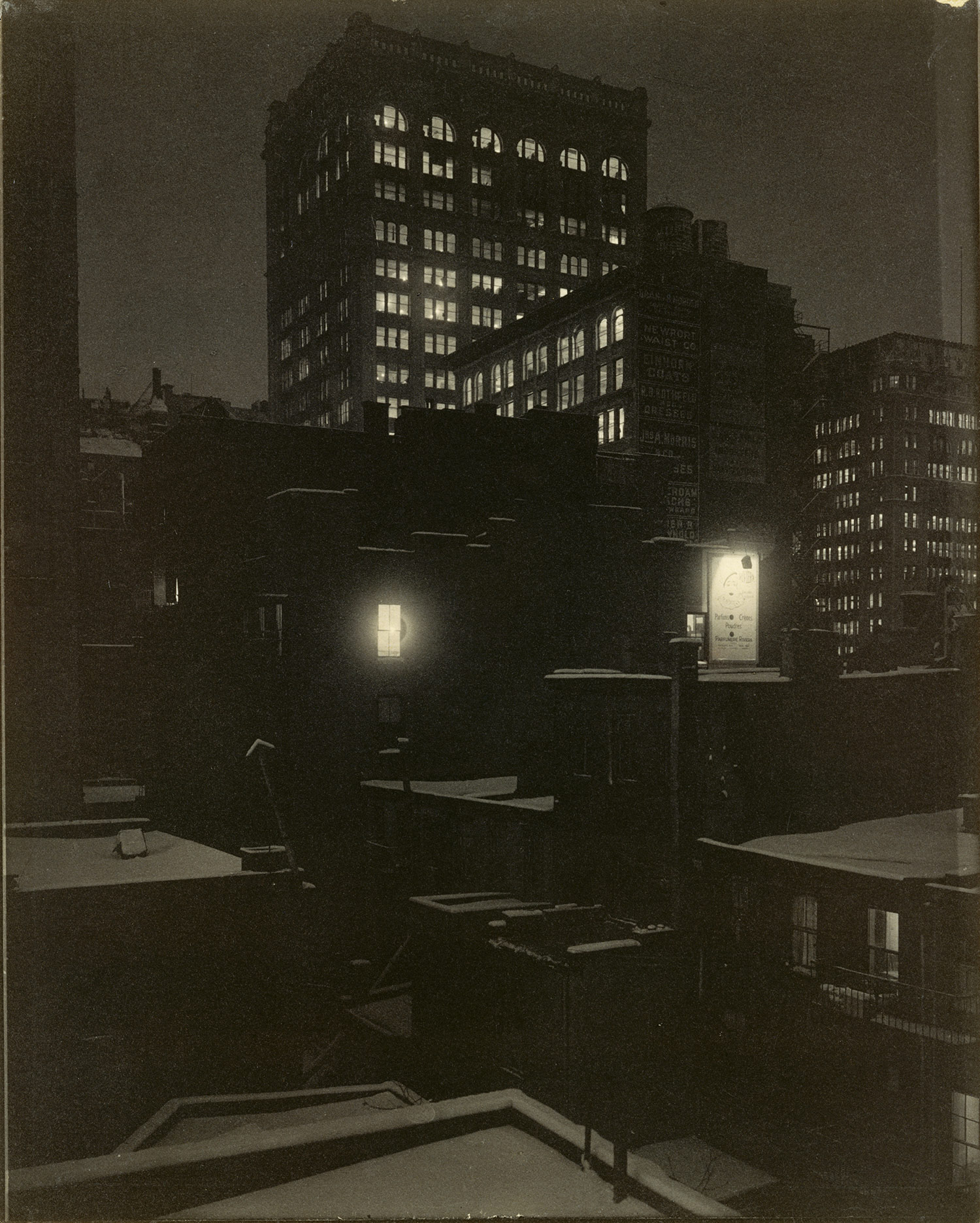
From the Back Window, 291, 1915
This is photograph that just could not be made today. As you look at this photograph notice that the main light in this shot is moon light, and how few gas/electric lights there are. With todays light pollution there is no way we would be able to balance the two different light sources. While the moon light makes the image rather spooky, what I really like the simple uncluttered composition.

Equivalent 1930
This is on the a series of abstract photographs that Stilglitz took as part of his ``Equivalents'' project. The series composed primarily of clouds, atmosphere, and light, in which cloud formations create various moods and textures. This was his attempt to “put down my philosophy of life—to show that photographs were not due to subject matter”.
Roll 3: A night at the Opera
 Friday, June 10, 2011 at 12:40PM
Friday, June 10, 2011 at 12:40PM These photographs were taken and developed back on some barmy February (2011) night. Night photography is something that has always intrigued me and this is the first time I was headed out to shoot a roll of film in these conditions.
Night photography is reasonable simple with a digital camera if you had a tripod and a cable release. With film there is two other things to keep in mind. One is the high contrast situation, street lights and a dark sky. The other is film reciprocity failure. Recently there was a new book publish on night Photography by Lance Keimig, the best part of this book is it looks a both using film and digital, I will give a review of this book in a future post.
The high contrast problem is about how many stops there are between the shadows you want to have detail in and the bright points or light. This refers back to the zone system and compensation developing. Something that I did not know at the time, hence it was not used here, I am still looking into it.
The film reciprocity failure is discussed in the my previous blog post here.

Proof Sheet 003
This is Fuji Across 100 developed in XTOL1:1 for 8:30 at 21C with agitation for the first minute and then for 10 seconds every minute afterwards. I used water as a stop bath, Kodak Rapid fixer for 5 minutes and finally Hypo Clear for 2 minutes before the final water wash.
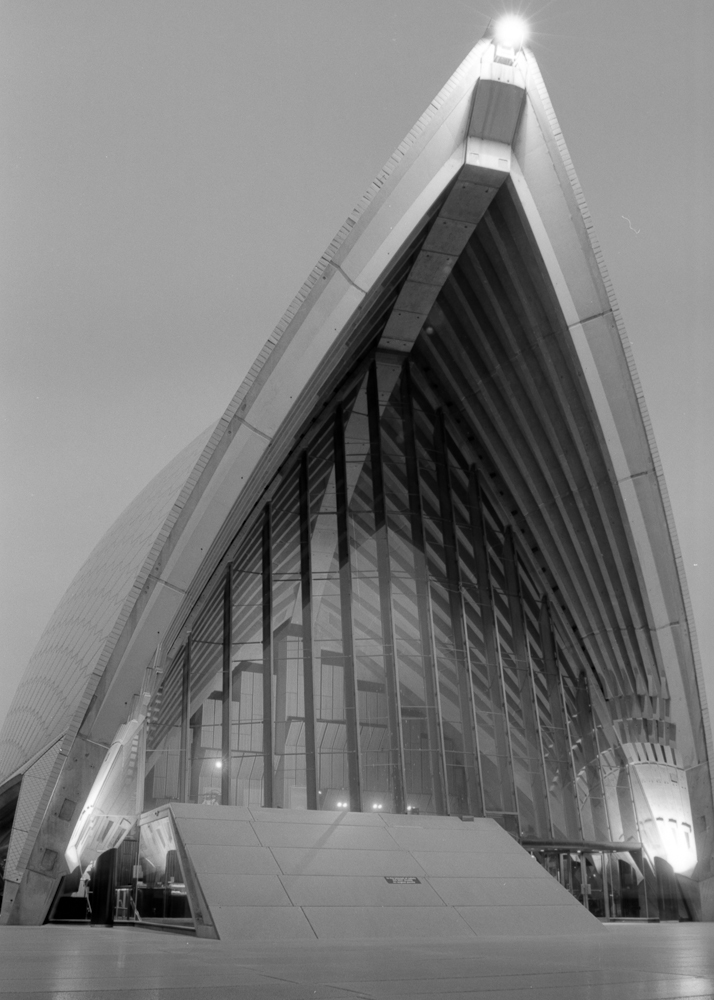
Inside the Sails
One of the problems with shooting such a well known landmark it is hard to find an original angle to make an interesting photograph from. While this may not be the original angle it was just a shot I had to get out of my system before looking for more unique angles. This is an important thing when taking a photograph or any touts destination get a good photograph of the classic angles before you go hunting for the less well know angle or find a brand new angle.

Opera House looking West
This was one of the early shots that I took during the sunset looking into the sun, here the sun is behind the sails sitting on or below the horizon. What I like about it is the gentleman on the right of shot and the way his back is ached. I like reoccurring geometrical objects and here his back and the opera house sails are similar shapes.

Three Sails
This is my favourite shoot that I took that night. When you first walk up to the opera house is a mass of stairs leading up to the doors, which don't always make into the photographs as the long shots are generally too far away for you to tell and that the sails are quite inspiring and you want to get get right up to them as quickly as you can.

Zig Zag Tiles
As night was starting to settle in I started to look for detail shots. These tiles are on the western most side of the opera house which is the side that is used as a screen during the vivid festival every year in May/June. Tonight though they were illuminated with the normal spot lights.

Escalator Motion
After getting every thing I could of the opera house during blue hour I still have a couple more frames to use up before I could develop the roll, so I went off in the hunt for more photographical inspiration. These escalators are not too far from Circular quay, and just screamed out to by shot symmetrically like this. I also used a long shutter speed to blur out the escalator steps to simplify the image.
Long Exposures: Film Reciprocity Failure
 Friday, June 10, 2011 at 2:57AM
Friday, June 10, 2011 at 2:57AM One of the things that I love about photography is the ability to capture images that you cannot see with the naked eye. In particular long exposures of sea scape, with silky smooth water and streaky clouds.

Rock Pool: Nikon D90, ISO 200 ,15mm, 67sec, f16
This image was taken with my Digital SLR in Cronulla over a year ago before I started to much around with film. If I was to go back there today to take this same shot film I would still shoot with a tripos and a cable release, but I would have to adjust the exposure because film has something that digital does not, but can easily be compensated for. But first lets revise the key concepts of exposure.
The foundation of exposure is the idea that you reduce the area of your aperture opening in half (increasing your f/stop by one stop eg f5.6 to f8) you have to double your exposure time (increase it by one stop, i.e. 1/60 to 1/30) to let in the same about of light to obtain the same photograph.
For example say we have just taken a photograph of a rock on the edge of the stream and that the correct exposure for the photograph was f5.6 at 1/8sec. Now suppose that we want to show more of the landscape in the shot to do this we would want a greater depth of field say f16. To take a shot at f16 (which is three stops away from f5.6 (f5.6, f8, f11, f16) we would then want to let in three more stops of light in which would give us a shutter time of 1sec (1/8, 1/4, 1/2, 1).
Relationships like this are said to be reciprocal. The reason for it is that if close the aperture down a stop we halve the amount of light which we compensate by doubling the stutter time. So what we have done here is 2*1/2=1, so there is no overall change in the exposure of the image.
Reciprocity failure occurs when this relationship no longer holds and is a byproduct of the way film records light. At its very core film photography is a chemical reaction where light provides the energy for the reaction to take place. This failure is inherent in all films to varying degrees and generally starts to occur at the 1 second mark. One notable exception is Fuji Across 100 does not suffer any reciprocity failure for exposures under 2:00.
I liken it to shaking up a bottle of soft drink and then opening it, the reaction starts off explosively and slowly drops away. So here you have given the bottle energy to perform the reaction, like having a lot of light hitting the film. Now if you were to open the bottle with out shaking it you will get a little bit of fizz to start with then a slow release of gas that will take a long time to release the same about of gas as when you shake up the bottle, which is similar to how reciprocity failure works.
For long exposures (longer then a second) we can adjust the exposure time to compensate for the reciprocity failure, if we do not we will end up with an underexposed photograph.
Below is a table with adjusted exposure times that compensated for the Reciprocity Failure. These time are given in the data sheets for each film, the Ilford sheets have a graph showing the adjusted times while Kodak and Fuji just have a table with how many stops to adjust you exposure by. Please note that all these times are for a meter reading with ISO 100.
| Meter at 100 ISO | Fuji Across 100 | Tmax/Delta 100 | Tri-X 400/ HP5/FP4 | T-Max/Delta 400 | |
| 1 | 1 | 1 | 1/4 | 1/4 | |
| 2 | 2 | 2 | 1/2 | 1/2 | |
| 4 | 4 | 6 | 1.5 | 1 | |
| 8 | 8 | 12 | 4 | 2 | |
| 15 | 15 | 30 | 12 | 6 | |
| 30 | 30 | 1:00 | 36 | 12 | |
| 1:00 | 1:00 | 2:00 | 1:30 | 30 | |
| 2:00 | 2:00 | 5:00 | 3:30 | 1:00 | |
| 4:00 | 6:00 | 10:00 | 8:00 | 2:00 | |
| 8:00 | 12:00 | 20:00 | 18:00 | 5:00 | |
| 15:00 | 25:00 | 50:00 | 40:00 | 10:00 | |
| 30:00 | 45:00 | - | 1:30:00 | 20:00 | |
| 1:00:00 | 1:30:00 | - | 3:30:00 | 50:00 | |
From Night Photography by Lance Keimig
Now just looking at this table one might be lead to believe that the best films to use for long exposures would be Kodak T-Max or Ilford Delta 400 as they have the shortest exposure times of any of the films given a meter reading at ISO 100. However there is another side effect that occurs with Reciprocity Failure and that is increased dynamic range.
Of course there might be a creative reason why you want more tonal range in your photograph in which case you get it automatically in a long exposure.
Lets see where this increased dynamic range comes from, to do this lets consider the following example. We have judged that the correct exposure for our shot is to be 4 seconds at ISO 100, the shadows are sitting at and exposure of 16 seconds (+2 stops) and the highlights are sitting at 1 seconds (-2 stops). Here we would have the dynamic range be 4 f stops of light. The below table shows the time for the exposures of the highlights, mid tones, shadows and then finally the dynamic range in f stops of light (rounded).
| Exposure metered at 4 seconds | |||||
| -2 stops | On Meter | + 2 stops | Range in Stops | ||
| Fuji Across 100 | 1 | 4 | 15 | (2+2)=4 | |
| T-Max/ Delta 100 | 1 | 6 | 30 | (6+2)=8 | |
| Tri-X 400/ HP5 /FP4 | 1/4 | 1.5 | 12 | (2+4)=6 | |
| T-Max /Delta 400 | 1/4 | 1 | 6 | (2+6)=8 | |
The original meter reading would have had a total range of 4 stops. Here we can see that only that only Fuji Across 100 keeps its tonal range while the others tonal range expands. The tonal range will only increase from here so it is quite easy to lose details in the shadows or blow the highlights if you are not careful. Now not all is lost as there are still two ways you can compensate for this, either just use Across 100 or adjust your development time or concentration.
So far I have only been using Fuji Across 100 for long exposure and as long as they are under 2min I have nothing to worry about as there is no failure to compensated for. What I want to start looking into is how you can control the tonal range on the negative though compensating development, there will be a blog post on this some time in the future.
Note: In this post I have only considered B&W film photography. When you start to use colour film for long exposures an extra difficulty occurs where you can experience colour shifts. The reason why this can happen is beach colour film contains three light-sensitive emulsion layers, which sometimes will have difference reciprocity properties. This colour shift can be corrected via the use of colour correction filters. Each individual films data sheet should should contain the specific filter that should be used.
